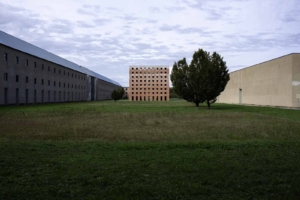Bologna University tour: top academic landmarks to visit

Welcome to "La Dotta" ("the Learned"). That's a nickname of Bologna to recall its academic tradition and intellectual history.
Bologna is home to one of the oldest universities in the Western world. If you're a history buff, an architecture lover, or simply curious about the city's educational heritage, a university-themed tour of Bologna is a must.
Let's take a walk through some of the city's most iconic university sites.
Archiginnasio and Anatomical Theatre
Our tour begins at the Archiginnasio, one of the most enduring symbols of the University of Bologna.
Built in the 1500s, this building was meant to consolidate university teaching, which was previously scattered across various locations.
As you enter, you’re greeted by a stunning porticoed courtyard, adorned with coats of arms and names of past students—a breathtaking tribute to the university's long and storied history.
Ascending the two grand staircases, you’ll discover the true gem of the building: the Anatomical Theatre.
Crafted entirely from fir wood, this unique space was once the venue for anatomy lessons, with a white table at its center where dissections were performed. The walls are lined with wooden statues of famous doctors, watching over the room—a striking reminder of the building’s academic past.
On the same floor, you'll find the Stabat Mater Hall, named after the first national performance of Gioachino Rossini's opera in 1842.
This richly decorated hall, a key part of the old university building, now serves as a venue for conferences and events. And just down the hall is the historic library, which, while only accessible to registered students, stands as a monument to centuries of learning.

Portico of Archiginnasio
Glossators' Tombs
To truly appreciate Bologna's academic history, a visit to the Glossators' Tombs is essential.
These "suspended" tombs, prominently displayed outside the Churches of San Domenico and San Francesco, honor the early professors and scholars of the medieval Studium—the precursor to the modern university. These scholars were known as glossators because they wrote explanatory notes, or "glossae," in the margins of Roman law texts.
Among the notable tombs is that of Accursio and his son Francesco, famous jurists whose work was central to the development of legal studies in Bologna.
Tip
Before going to the next place, make a stop in Piazza San Francesco for one of the best gelato in Bologna.
Botanical Garden and Herbarium
For a change of pace, let’s explore the Botanical Garden and Herbarium.
Established in 1568 by the renowned naturalist Ulisse Aldrovandi, this herbarium is one of the oldest in Europe.
- It houses an extensive collection of dried plants from the 16th century, carefully preserved to this day.
- The garden, located at Via Irnerio 42, includes four greenhouses—two tropical and two dedicated to succulent plants—as well as a fascinating collection of carnivorous plants.
The garden’s design reflects two exhibition approaches: displaying valuable individual collections and recreating natural environments.
It’s a peaceful spot, perfect for your leisure stroll in one of the best gardens in Bologna.

Wax Museum inside Palazzo Poggi
Palazzo Poggi: The University library and the anatomical wax Museum
The Archiginnasio served as the seat of the University of Bologna until 1803, when that role was transferred to Palazzo Poggi on Via Zamboni.
Even today, Palazzo Poggi remains a central hub for the university, with many faculties situated along Via Zamboni.
The tower of the Specola
The tower of the Specola, constructed to house the astronomical observatory, now contains a museum where you can see the instruments used by Bolognese astronomers throughout the centuries.
It also offers one of the best panoramic views of Bologna.
The University library
A few steps to visit the University Library.
This library is the beating heart of Bologna's academic life—a place for reading, research, and study.
As you wander through its halls filled with books, manuscripts, artworks, and antique furniture, you are effectively journeying through the history of knowledge.
Founded in the 18th century, the library boasts:
-
Over 1,250,000 volumes
-
A gallery of 400 portraits of notable scholars
-
Several 16th-century frescoes
This is one of the best libraries in Bologna, a real must-see for any history or book lover.
Ready to leave Palazzo Poggi? Not yet.
The anatomical wax Museum
The journey through Bologna’s university heritage wouldn’t be complete without a visit to the Anatomical Wax Museum.
This fascinating (and slightly eerie) museum showcases lifelike wax models of human anatomy, including bones, muscles, and tendons.
These meticulously crafted exhibits provide a unique look into the evolution of medical education over the centuries.

Collegio di Spagna
Collegio di Spagna
Founded in 1364 by Cardinal Egidio Albornoz, the Collegio di Spagna has continuously housed Spanish students enrolled at the University of Bologna for over six centuries.
Surrounded by high walls, the college features a beautiful 16th-century portico, leading to a brick courtyard where student rooms are situated.
Notable figures who have lived and studied here include:
-
Ignazio di Loyola, founder of the Jesuits
-
Miguel Cervantes, author of Don Quixote
-
Charles V, Holy Roman Emperor
Though the Collegio di Spagna remains an exclusive institution, open only to top Spanish students (preferably in law studies), you can still admire its stunning exterior or enjoy a meal at the traditional trattoria right in front of it.
Or, if you want to combine history and gastronomy, consider joining our Bologna food tour, where we introduce you to the city's rich culinary and academic traditions!
Want a private University Tour? Let’s make it happen!
Exploring Bologna’s university landmarks is like stepping into a living museum of knowledge, history, and culture.
From centuries-old libraries to hidden anatomical theaters, the city’s academic past is truly unparalleled.
Would you like a private guided tour of Bologna’s university treasures?
📩 Contact us today to arrange a personalized tour, where you’ll uncover the hidden stories and secrets behind the world’s oldest university.
We’d love to show you around!
[photo credits: Choo_Choo_train]


